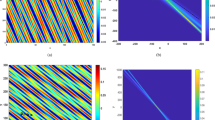Abstract
In this paper, two dimensional modified Boussinesq equation
under periodic boundary conditions is considered. It is proved that the above equation admits a Whitney smooth family of small-amplitude quasi-periodic solutions corresponding to finite dimensional invariant tori of an associated infinite dimensional Hamiltonian system. The proof is based on an infinite dimensional KAM theorem and Birkhoff normal form.
Similar content being viewed by others
References
Bambusi, M., Graffi, S.: Time quasi-periodic unbounded perturbations of Schrödinger operators and KAM methods. Commun. Math. Phys. 219, 465–480 (2001)
Bourgain, J.: Construction of quasi-periodic solutions for Hamiltonian perturbations of linear equations and applications to nonlinear PDE. Int. Math. Res. Not. 11, 475–497 (1994)
Bourgain, J.: Construction of periodic solutions of nonlinear wave equations in higher dimension. Geom. Funct. Anal. 5, 629–639 (1995)
Bourgain, J.: Quasi-periodic solutions of Hamiltonian perturbations of 2D linear Schrödinger equations. Ann. Math. 148, 363–439 (1998)
Bourgain, J.: Nonlinear Schrödinger Equations. Park City Series, vol. 5. American Mathematical Society, Providence (1999)
Bourgain, J.: Green’s Function Estimates for Lattice Schrödinger Operators and Applications. Annals of Mathematics Studies, vol. 158. Princeton Univ. Press, Princeton (2005)
Boussinesq, M.: Théorie générale des mouvements qui sout propagés dans un canal rectangularire horizontal. C. R. Acad. Sci. Paris 73, 256–260 (1871)
Boussinesq, M.: Théorie des ondes et des remous qui se propagent le long d’un canal rectangulaire horizontal, en communiquant au liquide contenu dans ce canal des vitesses sensiblement pareilles de la surface au fond. J. Math. Pure Appl. Sect. 17, 55–108 (1872)
Boussinesq, M.J.: Essai sur la théorie des eaux courantes. Mémoires présentés par divers savants á l’Académie des Sciences Inst. France 2, 1–680 (1877)
Chae, D.: Global regularity for the 2D Boussinesq equations with partial viscosity terms. Adv. Math. 203, 497–513 (2006)
Craig, W., Wayne, C.E.: Newton’s method and periodic solutions of nonlinear wave equations. Commun. Pure Appl. Math. 46, 1409–1498 (1993)
Eliasson, L.H., Kuksin, S.B.: KAM for the nonlinear Schrödinger equation. Ann. Math. 172, 371–435 (2010)
Eliasson, H., Grebert, B., Kuksin, S.B.: KAM for the nonlinear beam equation. Geom. Funct. Anal. 26, 1588–1715 (2016)
Geng, J., You, J.: A KAM theorem for one dimensional Schrödinger equation with periodic boundary conditions. J. Differ. Equ. 209, 1–56 (2005)
Geng, J., You, J.: A KAM theorem for Hamiltonian partial differential equations in higher dimensional spaces. Commun. Math. Phys 262, 343–372 (2006)
Geng, J., You, J.: KAM tori for higher dimensional beam equations with constant potentials. Nonlinearity 19, 2405–2423 (2006)
Geng, J., Xu, X., You, J.: An infinite dimensional KAM theorem and its application to the two dimensional cubic Schrödinger equation. Adv. Math. 226, 5361–5402 (2011)
Geng, J., Zhou, S.: An infinite dimensional KAM theorem with application to two dimensional completely resonant beam equation. J. Math. Phys. 59, 072702 (2018)
Kuksin, S.B.: Nearly Integrable Infinite-Dimensional Hamiltonian Systems. Lecture Notes in Mathematics, vol. 1556. Springer, Berlin (1993)
Kuksin, S.B., Pöschel, J.: Invariant Cantor manifolds of quasi-periodic oscillations for a nonlinear Schrödinger equation. Ann. Math. 143, 149–179 (1996)
Liang, Z., You, J.: Quasi-periodic solutions for 1D Schrödinger equations with higher order nonlinearity. SIAM J. Math. Anal. 36, 1965–1990 (2005)
Pöschel, J.: A KAM-theorem for some nonlinear partial differential equations. Ann. Scuola Norm. Sup. Pisa Cl. Sci. 23, 119–148 (1996)
Pöschel, J.: Quasi-periodic solutions for a nonlinear wave equation. Comment. Math. Helv. 71, 269–296 (1996)
Shi, Y., Xu, J., Xu, X.: On quasi-periodic solutions for a generalized Boussinesq equation. Nonlinear Anal. 105, 50–61 (2014)
Tao, L., Wu, J.: The 2D Boussinesq equations with vertical dissipation and linear stability of shear flows. J. Differ. Equ. 267, 1731–1747 (2019)
Wayne, C.E.: Periodic and quasi-periodic solutions of nonlinear wave equations via KAM theory. Commun. Math. Phys. 127, 479–528 (1990)
Ye, Z., Xu, X.: Global well-posedness of the 2D Boussinesq equations with fractional Laplacian dissipation. J. Differ. Equ. 260, 6716–6744 (2016)
Yuan, X.: Quasi-periodic solutions of completely resonant nonlinear wave equations. J. Differ. Equ. 230, 213–274 (2006)
Author information
Authors and Affiliations
Corresponding author
Additional information
Publisher's Note
Springer Nature remains neutral with regard to jurisdictional claims in published maps and institutional affiliations.
The first author is partially supported by NSFC Grant (11801492, 61877052, 11701498) and NSFJS Grant (BK 20170472), the Natural Science Foundation of the Jiangsu Higher Education Institutions of China (No. 19KJB120014). The second author is supported by the NSFC Grant (11871146).
Appendix
Appendix
For \(w\in \Sigma ,\) we have
where \( \{ q_n,{\bar{q}}_n \}_{ n\in {\mathbb {Z}}_{odd}^2 }\) are the coordinates of w on the bases \(\{\varphi _n,{\bar{\varphi }}_n \}_{ n\in {\mathbb {Z}}_{odd}^2 } , \) and \(\{r_n\}_{ n\in {\mathbb {Z}}_{odd}^2 } \) are weights with \(r_n=r_{-n}.\) In this appendix, we want to compute the Poisson product \(\{F,G\}\) in the coordinates \( \{ q_n,{\bar{q}}_n \}_{ n\in {\mathbb {Z}}_{odd}^2 }.\) Especially, we choose suitable weights \(\{r_n\}( { n\in {\mathbb {Z}}_{odd}^2 }) \) such that the Poisson product is a standard form. One has
Let \(A_n= \frac{ 1-|n|^2}{ 1+|n|^2 }, \) then
By (8.1), one has
Then the Frechet derivatives of \(q_n,{\bar{q}}_n \) with respect to w are
Denote by
For \(n,m \in {\mathbb {Z}}_{odd}^2\) we have
then
We choose \(r_n=r_{-n} =\sqrt{ \frac{ 1+|n|^2 }{2} }\) and then
Since
and \({\mathbb {J}} \) is anti-self-adjoint, we have
Inserting the gradient of G, then
Rights and permissions
About this article
Cite this article
Shi, Y., Xu, J. Quasi-periodic Solutions for Two Dimensional Modified Boussinesq Equation. J Dyn Diff Equat 33, 741–766 (2021). https://doi.org/10.1007/s10884-020-09829-4
Received:
Revised:
Published:
Issue Date:
DOI: https://doi.org/10.1007/s10884-020-09829-4



